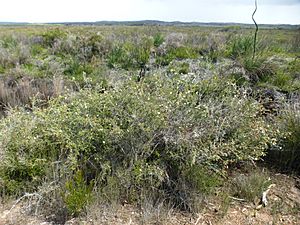Melaleuca incana subsp. incana facts for kids
Quick facts for kids Melaleuca incana subsp. incana |
|
|---|---|
 |
|
| Melaleuca incana subsp. incana growing near Point d'Entrecasteaux. | |
| Scientific classification |
|
| Kingdom: | Plantae |
| Clade: | Tracheophytes |
| Clade: | Angiosperms |
| Clade: | Eudicots |
| Clade: | Rosids |
| Order: | Myrtales |
| Family: | Myrtaceae |
| Genus: | Melaleuca |
| Species: | |
| Subspecies: |
M. i. subsp. incana
|
| Trinomial name | |
| Melaleuca incana subsp. incana |
|
The Grey Honey-Myrtle (scientific name: Melaleuca incana subsp. incana) is a type of plant. It belongs to the myrtle family, called Myrtaceae. This plant naturally grows only in the south-west part of Western Australia. It has also started growing on its own in southern Victoria, Australia. Many people like to grow the Grey Honey-Myrtle in their gardens. It produces many white or creamy yellow flowers when spring begins.
Contents
What Does Grey Honey-Myrtle Look Like?
Melaleuca incana subsp. incana is a medium to tall shrub. It has branches that hang down, making it look like it's weeping. This plant can grow up to about 3 metres (10 ft) (10 feet) tall. Its bark is rough and grey.
The leaves grow in pairs opposite each other. Sometimes, they grow in groups of three around the stem. They are curved and grow close together on the branches. Each leaf is about 3.5–17 millimetres (0.1–0.7 in) long and 0.5–3.5 millimetres (0.02–0.1 in) wide. They are long and narrow, like a line or a very thin oval, and they get narrower at the tip. Both the leaves and the new branches are covered with tiny, soft hairs. These hairs give the plant a grey look.
Flowers and Fruits
The flowers of the Grey Honey-Myrtle grow in spikes. These spikes are usually found at the ends of the branches. The branches keep growing even after the flowers bloom. Each spike has between 6 and 55 individual flowers. A spike can be up to 30 millimetres (1 in) (1.2 inches) long and 15 millimetres (0.6 in) (0.6 inches) wide. The flowers can be white, creamy white, or yellow.
The petals are small, about 0.7–2.0 millimetres (0.03–0.08 in) long. They fall off as the flower gets older. Inside the flower, there are five groups of stamens. Stamens are the parts that produce pollen. Each group has between 3 and 11 stamens. The Grey Honey-Myrtle mainly flowers in August and September. After flowering, it produces woody capsules. These capsules are 1.5–4 millimetres (0.06–0.2 in) long. They grow in cylinder-shaped clusters that can be up to 30 millimetres (1 in) long.
How Was Grey Honey-Myrtle Named?
This plant was first described in 1819 by a botanist named Robert Brown. He wrote about it in a book called Edward's Botanical Register. In this book, the plant was called "Grizzly Melaleuca."
The book mentioned that Mr. Brown first saw the plant in King George the Third's Sound. This area is on the south-west coast of New Holland (which is now Australia). Lady Aylesford provided the plant sample for the drawing in the book. The name incana comes from a Latin word meaning "hoary" or "white." This name refers to the greyish color of the plant's leaves.
Where Does Grey Honey-Myrtle Grow?
Melaleuca incana subsp. incana grows naturally in Western Australia. You can find it between the towns of Albany and Jurien Bay. It also grows inland as far as the Dryandra woodland. This area covers several different natural regions, including the Avon Wheatbelt, Geraldton Sandplains, Jarrah Forest, Swan Coastal Plain, and Warren regions.
This plant has also started growing on its own in other places. It is now found in the Gippsland and Otway plains areas of Victoria.
How People Use Grey Honey-Myrtle
Growing Grey Honey-Myrtle in Gardens
Melaleuca incana subspecies incana is a very popular plant for gardens. It is a strong plant that grows quickly. It can handle many different types of soil and conditions once it has settled in. It can also survive frost, which means it's good for colder areas.
You can easily buy this plant at garden stores. It can be trimmed to form a hedge, which is a row of closely planted shrubs. However, it can sometimes get attacked by tiny bugs called scale insects.
Images for kids



